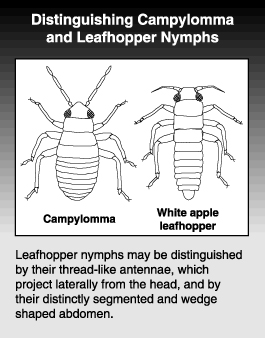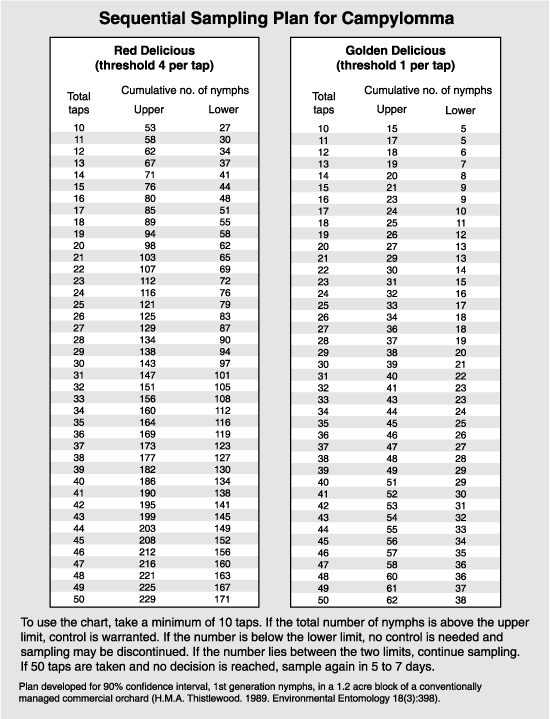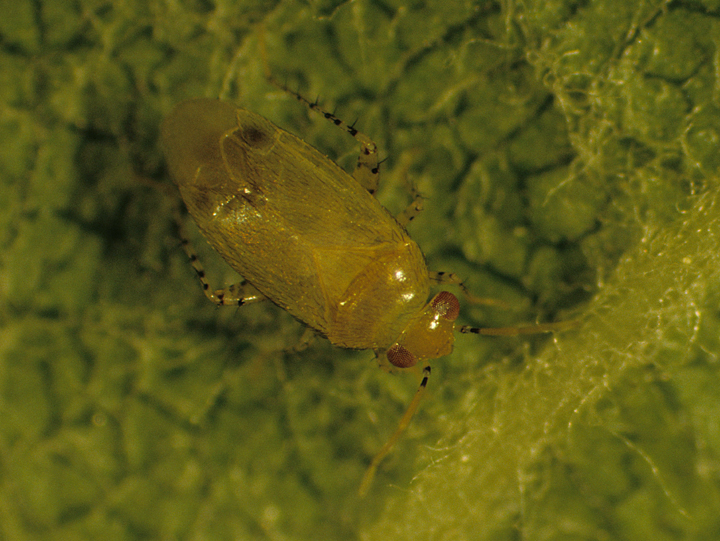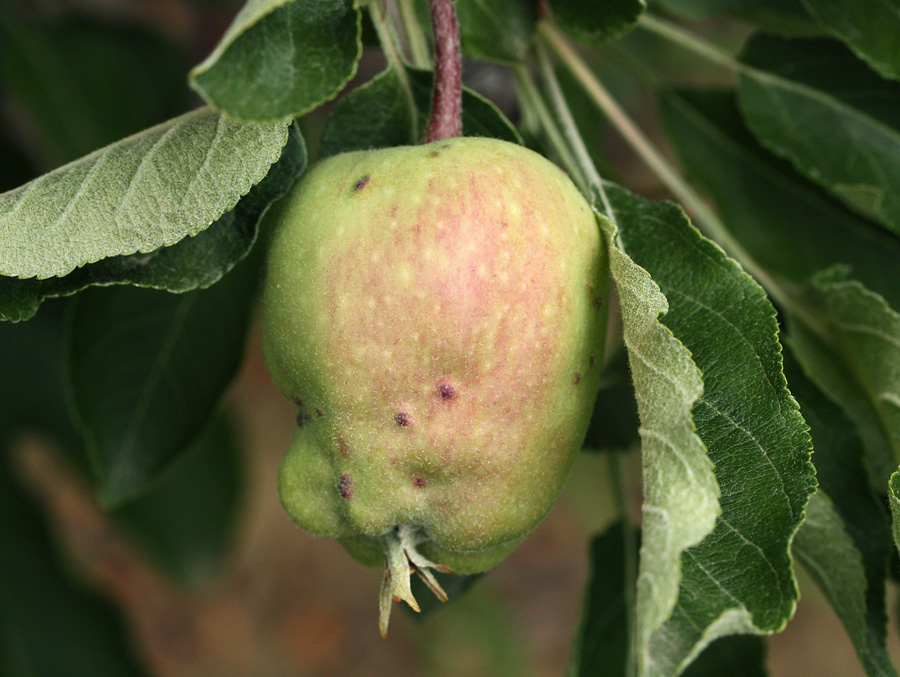by Elizabeth H. Beers, originally published 1993
Campylomma verbasci (Meyer-Dür) (Hemiptera: Miridae)

Campylomma is European or Asian in origin but was recorded from the eastern United States as early as 1886. Its area of distribution includes southeastern Canada and the northeastern United States, as far south as Virginia, and as far west as Iowa. In the West, it is recorded from British Columbia, Washington, Oregon, California, Idaho and Colorado. In Washington, reports of damage have come from throughout the main fruit growing region east of the Cascades (with the exception of Spokane/Greenbluff area), although problems have been more intense from Wenatchee to the Canadian border.
Campylomma was not reported as a pest in western North America until the early 1970s in British Columbia. Damage in Washington has occurred for several decades but was sporadic and primarily confined to the northern part of Okanogan County, bordering British Columbia. Damage increased dramatically in the mid- to late 1980s and became widespread in 1990. It also occurs now in eastern fruit growing districts, such as Michigan, New York, Pennsylvania, Virginia and West Virginia. In Europe and Asia it is reported only as a predator, usually of mites.
Hosts
Campylomma has two distinct types of hosts: a woody host which is necessary for the overwintering eggs and an herbaceous host which may be used for one or more generations during the summer. Although campylomma seems to need a woody host to complete its development, a herbaceous host may not be vital. Woody hosts include apple and pear, serviceberry, grape, oak, and wild rose. Herbaceous hosts include common mullein, Verbascum thapsus (hence the common name of this insect), potato, sugar beet, corn, small grains, and various weeds. In orchard areas, by far the greatest numbers have been found on mullein.
There appear to be distinct differences in susceptibility among tree fruit species and varieties, although it is not clear why. Damage to pears is quite rare even at high populations, although some damage to Bartlett has been reported from British Columbia. Of the two major apple varieties in the Pacific Northwest, Golden Delicious appears to be much more susceptible to damage (given an equivalent campylomma population) than Red Delicious, although both cultivars are damaged. McIntosh and Winesap do not appear to sustain any damage. Information on newer varieties is lacking, although Gala appears to be readily attacked.
Life stages
Egg
The overwintering egg is about 1/28 inch (0.87 mm) long and sac-shaped. It is inserted into the bark of host plants with only the operculum (lid or cover) exposed, making it almost impossible to see.
 Nymph
Nymph
The nymph is ovate and translucent when first hatched but gradually takes on a pale green color. Older nymphs have black spines on the legs. In its early instars, a campylomma nymph may be confused with a young white apple leafhopper nymph. However, the leafhopper nymph can be distinguished by its thread-like antennae which project laterally from the head and by its distinctly segmented and wedge shaped abdomen.
The campylomma nymph has thicker, four-segmented antennae, with a dark colored joint between the first and second segments. First instar campylomma nymphs have also been confused with predatory mites (Typhlodromus) and early instar aphids. An aphid may be distinguished by its globular shape, darker green color, and cornicles on the abdomen. Aphids are also much more sluggish than either campylomma or leafhoppers.
Adult
The adult is gray-brown, an elongated oval shape, and about 1/10 inch (2.5 mm) in length. Like the nymph, it has a dark spot on the first antennal segment and black spines on the legs
Life history
Campylomma overwinters as an egg, which is inserted deeply into the tissue of a woody host plant. Eggs hatch in the spring, beginning as early as tight cluster to pink stage of tree development and continuing through petal fall. Egg hatch peaks during or shortly after bloom. Nymphs pass through five instars. The total period of nymphal development depends on temperature and takes about 21 days at 72ºF.
Nymphs from the overwintering eggs may be present from mid-April to mid-June in central Washington. Adults first appear in mid- to late May. Studies of campylomma colonies on a herbaceous host showed females lived an average of 17 days and laid an average of 38 eggs. Eggs hatch in 7 to 13 days at constant temperatures between 68 and 81ºF. On apple and pear, the highest densities are usually detected in the spring, with minor peaks throughout the rest of the year. The majority of the campylomma population spends the summer on herbaceous hosts, especially mullein, so samples taken in tree fruits represent only a part of the population. In summer, campylomma feed on insects (primarily thrips) and on the host plant. In late August, adults begin migrating back to woody hosts, such as apple and pear, where they mate and lay overwintering eggs through October. Observations indicate 2 to 4 generations occur annually in the Pacific Northwest.
Damage
Campylomma is one of the few tree fruit pests in the Pacific Northwest that is also a predator. Throughout most of its distribution in Europe and Asia no fruit damage has been noted, and it has been reported as an important predator of mites and occasionally aphids. In the Pacific Northwest, it preys on aphids and pear psylla and can greatly enhance biological control of these species. However, for a relatively short period around bloom, it feeds on flower parts and developing fruitlets. Although fruit feeding may occur later than this period, it does not seem to cause damage. Early feeding causes a reaction in the fruit, producing a dark, raised, corky wart, often surrounded by a shallow depression . Feeding punctures can occur individually, or an entire quadrant of the fruit may be damaged. Multiple stings on a fruit usually cause some degree of fruit deformity. Stings tend to be more visible on the skin of Golden Delicious than on darker colored cultivars, and the scars may be a lighter tan color.
Monitoring
Campylomma may be sampled using several methods, depending on the stage and time of year. One of the most critical periods for sampling is before and during the bloom period, when a control decision should be made. Either a beating tray or direct visual examination can be used at this time. The beating tray takes less time to cover an area, but direct examination may reveal nymphs that are not jarred from the foliage using a beating tray. It is estimated that about 70% of the nymphs are recovered using the beating tray method.
 A standard beating tray is an 18-inch square piece of cloth stretched tautly on a wood or aluminum frame. A circular tray with a surface area of 324 square inches (a diameter of about 20.3 in) can also be used. The tray is placed beneath a limb with abundant foliage and flower clusters, and the limb is struck sharply three times with a length of thick rubber hose or cushioned wood. This is referred to as a tap sample. During the early season, a black cloth surface on the beating tray can make the translucent nymphs more visible. The accumulated pollen and debris that fall on the tray should be brushed or shaken off after each sample, and the surface should be washed when stains start to interfere with the ability to detect campylomma.
A standard beating tray is an 18-inch square piece of cloth stretched tautly on a wood or aluminum frame. A circular tray with a surface area of 324 square inches (a diameter of about 20.3 in) can also be used. The tray is placed beneath a limb with abundant foliage and flower clusters, and the limb is struck sharply three times with a length of thick rubber hose or cushioned wood. This is referred to as a tap sample. During the early season, a black cloth surface on the beating tray can make the translucent nymphs more visible. The accumulated pollen and debris that fall on the tray should be brushed or shaken off after each sample, and the surface should be washed when stains start to interfere with the ability to detect campylomma.
Action thresholds for campylomma are currently tied to the tap sample method. Action thresholds developed for British Columbia are an average of 1 nymph per tap for Golden Delicious and 4 nymphs per tap for Delicious. A sequential sampling plan was also developed under British Columbia conditions. Because the distribution of campylomma is aggregated, or clustered, a fairly high number of taps is needed to estimate the population with accuracy. Although neither the sampling plan nor the action thresholds have been validated under Washington conditions, they provide a good starting point. Note that this sampling plan was developed for 0.5 hectare (1.2 acre) blocks only. Realistically, any block of trees that are of the same age and managed similarly must suffice. If the block contains mixed cultivars, the most sensitive cultivar should be sampled. A fixed sample of 20 taps per block has been recommended in the past in absence of good statistical information. Although not precise, it will provide a rough estimate of the campylomma population.
In summer, when campylomma are most likely to be in or around aphid colonies, direct examination of the aphid infested terminals is probably the most efficient means of sampling. Both adults and nymphs can be monitored with either the beating tray or visual examination. Since no damage is known to occur during this time, there are no action thresholds.
In the fall, adults migrating back to orchards can be sampled with pheromone traps. A wing-type trap with spacers between the trap top and bottom is the most effective. Pheromone traps may be useful in separating orchards into risk categories so that sampling the following spring can be prioritized in high risk orchards.
 Biological Control
Biological Control
Biological control of campylomma may be difficult, since it is itself a predator. There are currently no reported natural enemies of campylomma that would be useful in a commercial situation.
Management
The first step in management must be to determine if a damaging population is present in the orchard. Damage the previous season has not always been a reliable indicator of damage to the current season’s crop, although it is advisable to sample those orchards where high levels of fruit damage occurred in the past. Some insecticides applied at delayed-dormant stage may kill early hatching campylomma nymphs. Thus, it is possible that several negative samples be taken before and during early bloom but, when residues of the delayed dormant application wear off, nymphs may be suddenly found in what was thought to be a clean orchard. If temperatures are warm during the pre-bloom period and tree development is rapid, or if there are few overwintering eggs, the delayed-dormant application may provide sufficient control. However, when cool weather extends the period from delayed-dormant to petal fall, or the number of overwintering eggs is high, an application targeted specifically for campylomma may be necessary. It is advisable to take repeated samples throughout the pink to petal fall period if no decision is reached. Spray timing is the key factor in preventing damage by campylomma. Petal fall sprays may fail to prevent much of the potential damage, even though they may kill the campylomma present. Pre-bloom and bloom sprays have been more successful in preventing fruit damage. Choice of materials at bloom is restricted to those that are less toxic to bees (see section on Honeybee). Most of the materials effective on campylomma are Class 1 bee toxicants and cannot be used during bloom. There may be some potential for cultural or behavioral controls for campylomma. Removing the summer hosts, such as mullein, may reduce potential campylomma problems. High campylomma populations in spring have been associated with high aphid populations the previous late summer and fall, when campylomma adults are laying overwintering eggs.
Campylomma Gallery
Materials available for apple
Excerpt from the WSU Crop Protection Guide. For timings at which each pesticide can be used refer to the Crop Protection Guide.





